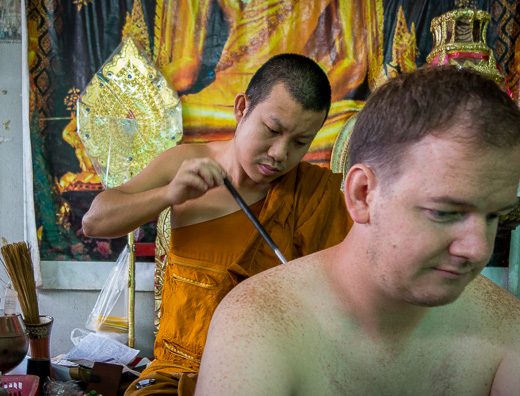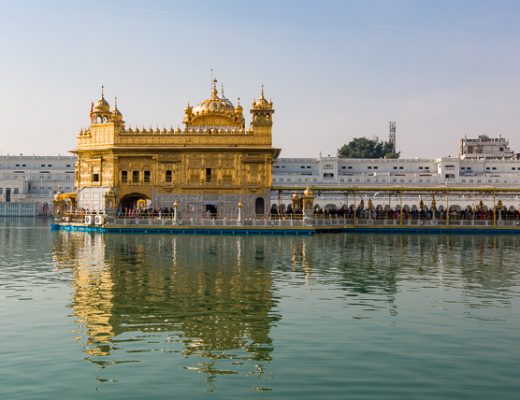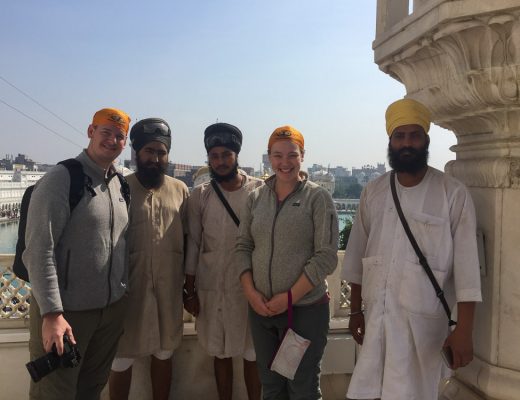**This is a graphic article. It contains explicit information about the crimes against humanity that occurred under the Khmer Rouge in Cambodia from 1975 – 1979. There is nothing fun about this but it is so incredibly important. I hope you read it. We were thanked by every Cambodian we saw on our day touring Choeung Ek and Tuol Sleng. It’s the only way it won’t happen again, they kept telling us.
If you want to read a really excellent summary of the Khmer Rouge’s rise to power, their reign, and their ultimate downfall, check out these articles from one of my favorite blogs. Also, we didn’t take any pictures while we were here. It felt wrong. If you want to see some of the sights we saw, you can click here.
They say the road to hell is paved with good intentions.
In this case, it was paved with concrete that had given way to expose its rebar causing a bumpy tuk tuk ride.
We were on our way to Choeung Ek, the killing fields, just 15km southeast of Cambodia’s capital, Phnom Penh. It wasn’t a trip that we were looking forward to, but something we knew we had to do.
Even with our limited knowledge of the events that took place during those three years, eight months, and twenty days, the drive to Choeung Ek felt ominous.
We were taking the same route that thousands of people took to their death.
It started on April 17, 1975. (Actually there were a lot of things that happened leading up to that day in April, so check out the articles I listed above for a more comprehensive take.) The Khmer Rouge rolled into Phnom Penh after years of civil war and people celebrated. They were hopeful that the last years of violence and hunger had finally ended. Within hours, the Khmer Rouge had started evacuating the 2.5 million people that lived in Phnom Penh sending them into the countryside. The goal of the Khmer Rouge (Khmer are the people of Cambodia and rouge meaning red in a nod to the communist party) was to create an agrarian utopia. Pol Pot, the leader of the Khmer Rouge, wanted a society without any social institutions; no banks, religions, modern technologies, education, etc.
Pot declared it “Year Zero” and started exterminating anyone who didn’t fit in his new ideal. “What is rotten must be removed,” claimed the Khmer Rouge and the murders started. Doctors, lawyers, teachers, city dwellers, people who wore glasses, artists, ethnic minorities, religious groups, religious leaders, Westerners, anyone with higher education, anyone who spoke more than one language, or anyone else who was perceived as a threat to the new Communist Regime, including Khmer Rouge soldiers, were taken to two places; prisons to be tortured or the killing fields. By the time the Khmer Rouge was stopped, they had killed one quarter of the Cambodian population, between 2 and 3 million people. It is estimated that half of those deaths occurred at the killing fields or prisons while the other half was from exhaustion, starvation or sickness of those working in the fields.
We arrived at Choeung Ek, got our tickets, grabbed our audio guides, and entered the gates. It was amazing how peaceful the area would’ve been if you didn’t know about the atrocities that were committed on this very site. The birds were chirping, the sun was shining, the trees and grass were lush and green, and there were childrens’ voices that could be heard from what I am assuming was a nearby school.
We were soon snapped back to reality by the giant structure that loomed before us, the memorial stupa which, if you looked through the glass windows and past the glare, housed the skulls of thousands of people murdered here.
The first stop on the tour was called the truck stop. It was here that the Cambodians who didn’t meet Pot’s ideal were brought, blindfolded, and by the truckload to be killed. The people in the truck didn’t know where they were headed. A Khmer Rouge guard interviewed for the audio guide said that they would tell the prisoners they were being relocated to a new home so they wouldn’t have mass chaos on the trucks. At first, we were told, they would have a truckload of 50 or so people a few times a week, but as the regime’s rule continued, and as Pot got more and more paranoid, they were bringing multiple truckloads, up to 300 people, each day.
When people arrived at Choeung Ek, they were usually killed immediately. The Khmer Rouge didn’t want to spend money on bullets, so people were killed most often with blunt objects such as hoes, axes, hammers, or even the leaves of the sugar palm which are reminiscent of shark teeth. They lined up the victims near the pits that they had already dug so it was less work moving bodies. Towards the end, when they were transporting too many people to kill in one night, they built a windowless building where they would store the prisoners before they killed them. There was no lack of horror in this place.
As we continued along the tour we saw the remnants of a building where the chemical substances like DDT, were housed. DDT was commonly spread over the bodies in the mass graves for two reasons: to kill anyone who may still be alive and to help with the smell of the bodies decomposing.
As we turned the corner, we got a panoramic view of the grounds. The grass was pock-marked with huge rectangular divots that went as far as the eye could see. Sprinkled across the grassy area were thatched roofs which marked mass graves that had been found. There are still many bodies buried at Choeung Ek, but the authorities have decided to leave them be. Signs and our audio guide told us repeatedly to stay on the trail, and to avoid any bones or teeth that we might see on the ground, since they continue to appear as rain and wind influence the land.
We were already intermittently tearing up but the worst was yet to come.
We saw several glass boxes that were filled with clothing, teeth, and bones that have been found over the last 37 years. A tiny pair of purple shorts that obviously had a very young owner were devastating.
While the ground was filled with remnants of an awful time, the soil wasn’t the only part of nature used by the Khmer Rouge for cruelty.
There were two trees that have been named and were specifically marked off at Choeung Ek. “The Magic Tree” was a tree full of roots and like all things at Choeung Ek, if it didn’t have its sordid history, we would probably have stopped and enjoyed its gnarleyness. Yet, this tree was where they hung speakers for the music that they played. The music, we were told, had one purpose. To muffle the sounds of the prisoners as they were killed. We got to listen to a clip of the music with the diesel generator that they ran, it was a haunting sound.
The second tree is the part of Choeung Ek that will forever haunt me. The entire place was filled with horrors that no one should endure, but “The Killing Tree” pushed me over the edge. The tree was where Khmer Rouge guards would kill babies and children by crushing their skulls against the tree trunk. Now decorated with gifts, the audio guide told us of the things that used to be found on this tree, and it was too much.
But these wicked acts weren’t taking place only at the 300 killing fields like Choeung Ek. Oftentimes, people were coming to Choeung Ek and other killing fields from one of the more than 200 prisons where they were being tortured first. Tuol Sleng, known as S-21, was one of those prisons, and that was our next stop.
We got back into our tuk tuk with our driver, Tan, and sat silently for our ride back to Phnom Penh. There was so much to process. Feelings of anger and frustration merged with heartbreak and soul-crushing sadness. How could this happen? How could Pol Pot and his Khmer Rouge regime kill their own people? Why did no one step in to help sooner? Why is a member of the Khmer Rouge the current Prime Minister of Cambodia? Why did Australia, the UK, and the US continue to recognize the Khmer Rouge as the only real government and provide them with a seat in the UN and aid for years after these atrocities? Why were the orchestrators of this horrible genocide like event never really brought to justice?
And then it was time to visit Tuol Sleng.


